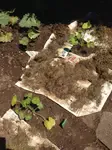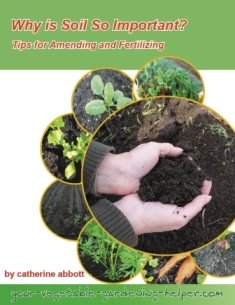Alternative Vegetable Garden Designs
Alternative vegetable garden designs can be made from almost any kind of item that will hold soil or any area with a little earth can be turned into a productive vegetable garden.
Even in a concrete jungle there are lots of opportunities to start growing some of your own food.
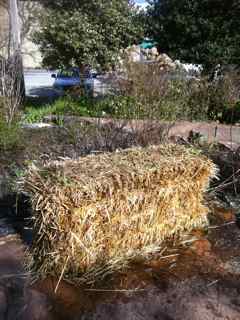 Set you bale with the twine on the side to keep the bale together as it decomposes.
Set you bale with the twine on the side to keep the bale together as it decomposes.Alternative Vegetable Garden Designs:
Straw Bale Garden
Straw bale gardening is an alternative vegetable garden designs where plants and seeds are grown in straw bales rather than soil. Because it is a method using very little if any soil it is sometimes considered a form of hydroponic gardening.
It is a great way to grow annual vegetables, herbs, or flowers in an area where there is little soil available or an area that has very poor soil.
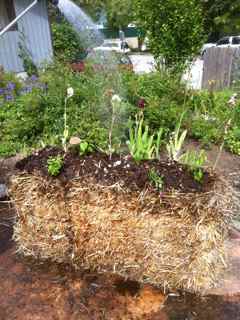 Lettuce and Bok choi
Lettuce and Bok choiA bale garden can be placed on a patio or balcony where there is no soil in sight, making it a great option for a small urban garden.
Since the bale is a couple feet in height you will be growing your plants a few feet above the ground, which makes gardening easier for disabled, older gardeners, or for those gardening that suffer from aches and pains when bending or kneeling.
Wheat straw is recommended, however oat straw will work just as well and avoid pine and hay bales.
Hay bales have grass seed, which can cause a weed problem in your bale garden.
Straw is the stem of the grain, which is separated then baled, whereas a hay bale is the entire plant including the stem, leaves and seed heads.
It is best to use a bale that is bound by synthetic twine as the twine will not rot as quickly as a natural one, keeping the bale intact longer.
Make your garden:
- Place the bale where you want to grow your alternative vegetable garden designs as it will get very heavy once wet and will not be easy to move.
- Place the bale so the string runs around the bale, you do not want the string to come into contact with the ground.
- To cure the bale you will want to thoroughly wet it (if you can find a bale that is already partially decomposed you will be ahead in the process). The wet bale will heat up as it decomposes, this process will take a week to ten days then it will start to cool down. To quicken this process you can wrap the bale in plastic and lightly sprinkle five ounces of ammonium nitrate on the fourth day of decomposition. Once the bale starts to cool down you can plant your veggies.
- If you want to start with seeds lay two or three inches of compost, potting soil, or peat moss on top of the bale like you are icing a cake. You can plant your seeds directly into the soil and the plant roots will grow into the straw.
- If you are planting transplants you can put them directly into the bale rather than adding soil. To transplant take a sharp trowel and thrust it into the bale and lever the trowel forcing the bale to come apart. Pop in the transplant and let the bale spring back to the original shape.
- In both cases direct seeding and planting transplants you will need to thoroughly water the bale.
- A straw bale garden will last one or two seasons. It is important to keep the bale moist throughout the season.
- Since there is none or very little soil for the plants to access nutrients it is important to fertilize your bale garden weekly (if you want it to last one season) or every second week (to have it last two years).
- Use compost tea or an organic multi-purpose fertilizer to keep your plants growing and producing an abundant harvest. You can add worms to the bale as well if you only want to use the bale for one season.
- Worms and feeding the bale will increase the decomposition process of the bale.
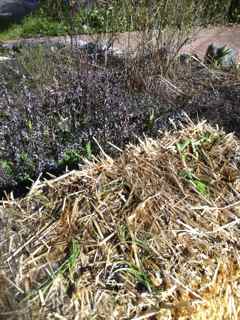 Chives planted.
Chives planted.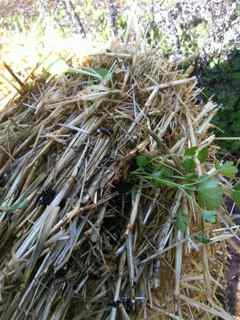 Cilantro on the side of the bale.
Cilantro on the side of the bale.What to plant in your straw bale garden:
- 6 cucumber plants
- 3 each of squash, zucchini, or melon plants
- 2 tomato plants (smaller varieties)
- 4 pepper plants
- 12 to 15 bean or pea plants
- 12 to 16 lettuce, Swiss chard, and annual herbs
Tall plants such as corn, pole beans, or large tomato plants are not necessarily the best plants to grow this alternative vegetable garden designs as it is difficult to put stakes into the bale and it may topple if it gets top heavy.
Root crops are not recommended in this type of garden as the straw will compress their roots rather than allow them to grow to maturity
You can use one bale or position several to make an even more interesting vegetable garden designs.
After one or two years of growing veggies in the straw bale it can then be added to your compost or used as mulch for other garden beds.
Recent Articles
-
Organic Gardening soil amendments - List of material?
Aug 09, 25 10:57 AM
What materials are best used as organic gardening soil amendments? -
Tips for disease control in your vegetable garden
Jul 14, 25 11:15 AM
Easy tips for disease control to keep your vegetable growing its best. -
Joy of vegetable Gardening
Jul 14, 25 11:01 AM
Everything you need to know is right here to have Joy of Vegetable Gardening
